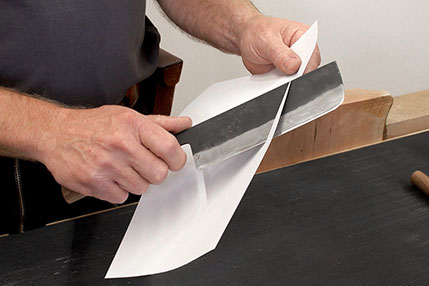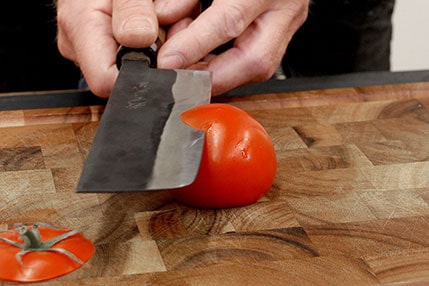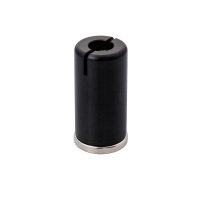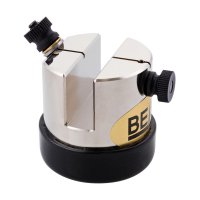
After sharpening, many people like to know whether the effort was worth it and whether the knife blades or cutting-tool edges are “really sharp” again. There are numerous ways to demonstrate sharpness. However, most sharpness tests only allow a subjective comparison between sharp and dull. With Edge-on-up sharp check, you can measure sharpness objectively.
Fragwürdige »Schärfetests«

Only a blade without nicks, cuts the edge of the paper in one go

Only sharp knives find a starting point in the curved paper surface
After sharpening, many people test the result of the sharpening process with different methods. You can watch the following methods in our video:
- Shaving hair
Shaving off hair on the forearm or back of the hand is not very informative. Even with a blade that is only moderately polished, hair can be easily removed or scraped off. Since knives are often used and sharpened in the kitchen, you should also consider whether you really want to have “hair in your soup”. - Cutting paper
This method is very controversial. On the one hand, it depends on the paper being used, and on the other hand, cutting paper will quickly make the just-sharpened edge dull again. However, a slowly drawn cut with the entire length of the face width, applied to the edge of the paper, makes it easy to detect even the smallest nicks in the cutting edge. A sharp knife also cuts into the surface of a slightly curved sheet of paper. An impressive demonstration of sharpness is to fold a sheet of paper in the middle so that you can set it up, and then cut it in half with one firm cut.
Testing in the right medium

Blunt knives slip on the smooth surface of the tomato skin

The short fibres of the end wood are a good indicator of sharpness.
The best way to test sharpness is to use the medium for which the blades are intended. For example, test kitchen knives by cutting into vegetables and test cutting-tools edges on wood.
- Tomato test for chef's knives
There are two testing methods you can do with tomatoes. In the first one, you place the knife on the side of the smooth surface of the tomato skin and pull it towards you without applying pressure. With a sharp edge, you will cut a thin slice off the tomato. A dull blade will either slip right off or only make a shortcut into the tomato. For the second tomato test, cut off the top of the stem and place the tomato with the cutting surface on a cutting board. Now make horizontal cuts through the tomato with a sharp blade. A blunt knife will only push the tomato across the board. - Fine chips in end grain for chisels and plane blades
A good way to test the sharpness of chisels or plane blades is to use the smooth end grain edge of a board. If you can take thin and, especially, smooth chips from the end grain with your tool, it is a good sign that the cutting edge is sharp. The cutting surface should be smooth and shiny. If there are still nicks in the cutting edge, they will leave clearly visible streaks in the end grain.
All the methods mentioned so far do not provide an objective measurement result. You can use them to determine whether an edge is sharp or dull, but you cannot make any statement about how sharp a blade really is or compare the sharpness of different knives with each other.
Objective edge tests
But how can I test sharpness objectively? How to measure sharpness?
Mike Brubacher, developer and owner of Edge-On-Up, also asked himself these questions. The result is a measuring method with which sharpness can be scientifically measured. The basic principle of the Edge-On-Up sharp check is easily explained:
A standardized test medium, a thin synthetic wire, is clamped into a holder. The holder is placed on a precision scale that measures the pressure needed to push the measuring wire through. The pressure is measured in grams. The result can be used to objectively assess the sharpness using the “BESS C scale”. By standardizing the test medium and the measuring method, the Edge-On-Up sharp check provides a user-friendly and repeatable method for determining sharpness..

Sharpness can be measured and compared with the sharp check
The BESS scale
The BESS value determined is the maximum weight in grams needed to cut the test wire. A sharp blade needs less pressure to cut through the wire than a blunt one. So the higher the BESS value, the duller the blade, or the lower it is, the sharper the blade. Since these are numerical values, the values can be compared with each other. For example, a freshly sharpened, double-edged razor only needs about 50 BESS to cut the wire. The sharpness of a freshly sharpened kitchen knife is between approx. 220 and 380 BESS. Above a value of 400 BESS, most knives and tools should be resharpened, unless it is a butter knife, which may have a BESS value of 2000.








